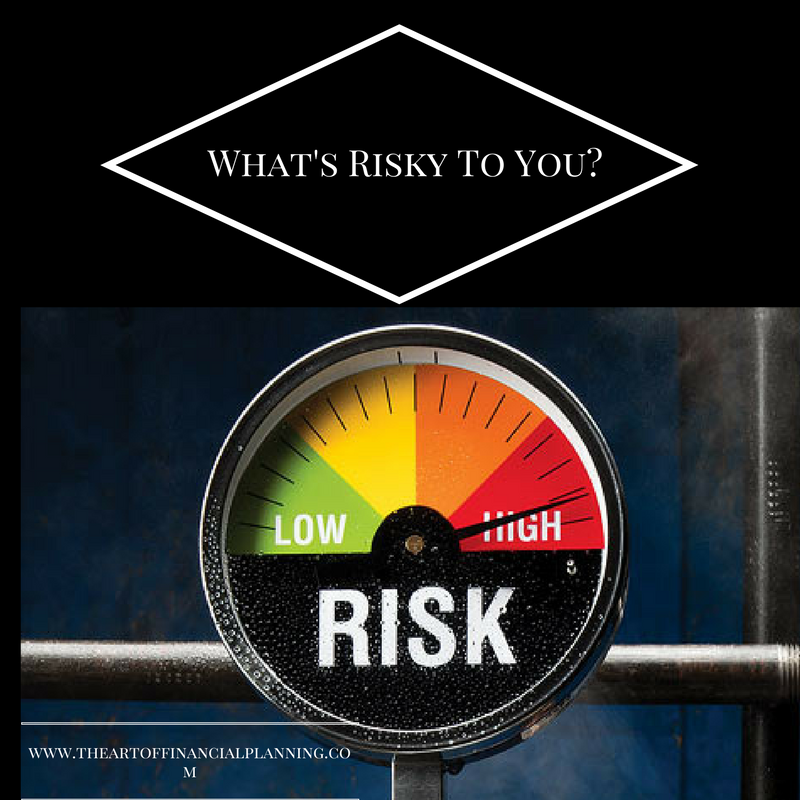 What Is Risky to You?
What Is Risky to You?
In financial planning, not saving enough money to accomplish your goals is the biggest risk you can take. Thinking that things will just work out and money will fall like manna from heaven is not only risky, but crazy too..
By not saving money you are setting yourself up for disappointment.
Find your dream house – but don’t have the down payment
Ready to stop working – don’t have enough money to replace your income
The roof springs a leak – you don’t have enough money to fix it without going into debt
Understanding these risks and finding how much you need to save is the best way to mitigate them.
When buying stocks and bonds, risk is viewed differently and oftentimes, investors think of risk only in terms of possibly losing money.
However, in the investment world, risk is broadly defined as the probability that the actual return from an investment will be different from its expected return.
Think about that.
The measurement of “HOW” different is the risk.
Actual returns (making or losing money) can be affected by a number of factors, and total risk is a measure of variation in return due to all sources.
In this post I will cover a variety of different sources of risk that can affect your portfolio.
General Risk
General risk refers to factors that lie outside individual companies, but that affect an entire class of investments, or the market as a whole (although individual companies may be affected to varying degrees).
One type of general risk, known as market risk, may be a function of political, economic, and sociological events, or changes in investor preferences.
For example, market risk occurs when the overall business climate changes, bringing expectations of lower corporate profits in general, and causing the larger body of common stock prices to fall.
A second general factor that may broadly affect all companies is interest rate risk—the fluctuations in the general level of interest rates. The bond market is particularly sensitive to interest rate risk in that bond prices tend to move in the opposite direction of interest rates. Although fixed-income securities (such as bonds) are generally the securities most affected by interest rate risk, other investment vehicles may be affected as well. Companies that borrow heavily for plants and equipment (e.g., utilities) may see their common stock prices affected by changes in the cost of borrowing.
A third general risk factor is purchasing power risk—the impact of inflation (a general rise in prices) or deflation (a general fall in price levels) on an investment. Purchasing power risk is a reflection of the uncertainty of price levels during the time an investment is held, particularly the inability of a particular investment to keep pace with inflation. Here is a great history of inflation rate data. (not endorsed by IFS)
For example, if an investment returns 3% annually, but inflation averages 4% annually during the holding period, the investor will be losing purchasing power by holding the investment. Purchasing power risk is generally highest in investments paying relatively low fixed-interest rates, such as savings accounts. This can hurt retiree’s tremendously. If they are living on a fixed income that doesn’t grow and the cost of everything around them goes up they are negatively impacted big time.
Specific Risk
In contrast to general risk, specific risk is that portion of total risk that is unique to a firm, industry, or property (in the case of a real estate investment). Specific risk is typically subdivided into business risk and financial risk.
Business risk is the risk associated with the nature of the enterprise itself (or the industry in which the enterprise resides) and measures the company’s ability to meet its obligations, remain a profitable entity, and provide acceptable returns to investors. It is generally believed that similar kinds of firms or properties have similar business risk. However, among similar businesses, differences in management, operating costs, and market opportunities can create different levels of business risk.
Financial risk measures a company’s mix of debt and equity used to finance its operations. Debt creates legal obligations (i.e., principal and interest payments) that must be met before earnings are distributed to owners (e.g., dividends to stockholders). The larger the proportion of debt, the greater the financial risk.
Portfolio Risk
Risk can be affected by political, social, and economic influences. Consequently, fitting individual risk tolerance to specific investments is an ongoing process that examines the interplay between the individual investor’s objectives and the constantly changing sources of risk that can impact investment returns.
As always, you can consult with me to discuss the risk in your portfolio.
Look for future posts on the best ways to mange your money and check out more financial wisdom here
Lastly click here to sign up for all great stuff The Art of Financial Planning has to offer!
Thanks for stopping by and I hope you achieve financial success!


